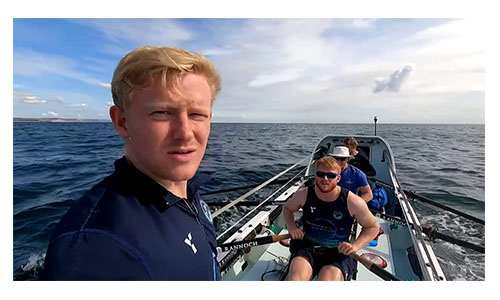The second in this series of updates from Jack Friend in which he talks trade winds and shift patterns.
Another few weeks closer to the start line of the Talisker Whisky Atlantic Challenge and things are starting to get very exciting! The Friendship Team will fly out to the start line at San Sebastian, La Gomera, The Canary Islands in less than a week. Once we arrive we will have just under two weeks to bring all the final pieces together and get ourselves ready to take on the challenge of a lifetime.
For this week's update, I thought I would tell you all a bit more about the challenge itself and give a bit of a flavor of what is in store when we set off. The route will take us from the Canaries to Antigua, this is approximately 3000 nautical miles or 5000 kilometers in a straight line but we will likely end up rowing a good amount further than that as we may head further south to capitalize on the trade winds.
For those who are interested the Atlantic trade winds will be the driving force behind our route choice. The tradewinds have enabled sailors (and rowers!) to cross the Atlantic for hundreds of years and we will be hoping to capitalize on them to support our rowing effort - in the best-case scenario we will have a strong following breeze to push us in the right direction but the ultimate aim is to avoid rowing into strong headwinds which can quickly stop us in our tracks (anything above 15 knots or 13mph against us will become nearly impossible to make headway against). The tradewinds and associated ocean currents are formed between about 30 degrees north and 30 degrees south of the equator, in a region called the horse latitudes. The Earth's rotation causes air to slant toward the equator in a southwesterly direction in the northern hemisphere and in a northwesterly direction in the southern hemisphere - known as the Coriolis Effect.
The Coriolis Effect, in combination with an area of high pressure, causes the trade winds to move from east to west on both sides of the equator across this 60-degree belt.
So in short our aim will be to balance the benefits of taking a direct route West to minimise the distance by dipping South in order to get benefit from the trade winds. This is not an exact science by any means and there is a lot of skill required to read the weather and its local effects as well as the impact of any weather systems that might form in the North Atlantic. As a team, we are lucky to have two shore-based weather routers in the form of Dick Koopmans and John Shoulten who will provide us with up-to-date weather information and advice on our course. We will speak to them on a daily basis via our satellite phone, feeding back the ‘real’ conditions we are experiencing for them to feed into their weather models and forecasts. Ultimately helping us set a course that balances all the variables and considers our position in relation to incoming weather systems.
Once our course is set we will be focused on maximizing the boat speed. The main thing we can do is row hard hour after hour for twenty-four hours a day. We will row in a shift pattern of two hours on and two hours off, with two of us rowing and two of us resting. Two hours of rowing enables us to row hard when we are on the oars - after two hours fatigue means output on the oars drops significantly. Two hours off the oars gives us just enough time to clean off the salt and sweat (using biodegradable wet wipes), refuel our bodies, clean the boat, navigate, manage our communications and if we are lucky then we can squeeze in 90 minutes of shut-eye.
It’s a grueling routine and it will push our bodies to their absolute limits as we each row 12 hours out of every 24 for up to 50 days and battle extreme fatigue, salt sores, and dehydration. While we will aim to consume between 5000 - 6000 calories a day we will likely all lose up to 10-15% of our body weight before we reach Antigua.
So what has driven us to take on this adventure, and why despite knowing all of the above are we still excited to get to the start line?!
Well, there are two key reasons for us, the first is that we have the opportunity to do this as Brothers. As two sets of twins, so close in age we have always enjoyed pushing each other and doing things together but as we get older life increasingly gets in the way. This has been an incredible opportunity for us to focus on something, challenge ourselves and see what we can achieve together. The second key driver for us is the opportunity to raise a significant amount of money for three causes that are very close to our hearts (more on this in the next update). It really is a once-in-a-lifetime opportunity and we cannot be more excited to see where it takes us.
There will be tough times ahead but we will weather the storms and come out the other side stronger - surely that is what life is all about! Well, that and the beautiful sunsets…
Do take a look at our website and consider donating to our charity campaign - www.thefriendshipatlantic.com
How would you like to share this?

